
The deep thrum of a helicopter from somewhere above the treeline is the first sign that Matt Wright, Nat Geo TV’s Outback Wrangler is about to arrive to say g’day.
Like meeting any ‘personality’ these days, there’s always a question in the mind whether they are ‘just like they are on TV’ or totally different. It only takes a hello and a handshake to confirm Matt is a regular knockabout bloke. Of course, this particular bloke is living an awesome dream: producing his own TV show, capturing (and relocating) rogue crocs, and running a successful Top End tourism operation about an hour or so west of Darwin.
The weekend I catch up with Matt is, as always for him, particularly frantic; there’s a tour group to entertain via one of his other business ventures (Outback Floatplane Adventures), a pesky 4X4 Australia journo (yep, that’d be me) to host for a day or so, and some last-minute filming to be done by Nat Geo TV for Season 3 of the hugely popular Outback Wrangler.

No sooner have we exchanged pleasantries than I have thrown my gear into his 79 Series Cruiser ute for a later pick-up and jumped aboard one of Matt’s airboats following a swamp channel to the Outback Floatplane Adventures pontoon on Sweets Lagoon. Here, guests are waiting to meet one of Australia’s most unique – and unassuming – television personalities.
In the beginning
When viewers watch Season 3 of Outback Wrangler they will see an experienced main presenter, but what they won’t see is the many years of hard graft and lessons learned along the way to this point, and it all started back in 2006 with Matt’s idea of showcasing the life he leads and the country – and people – that he lives in.
“My friends and family had no idea what sort of stuff we did,” Matt says, referring to his pre-TV career of mustering, breaking-in brumbies, catching crocs and collecting croc eggs. “So I thought we’ll just do a little local show – just try something – and base it a bit on what Troy Dann had done [the ’90s-era Troy Dann’s Outback Adventures]. “I used to like his show; it showcased the landscape... I wanted to showcase the country and the people that were in it, and that’s where it started.
But Jesus, it has taken a lot of years...” The journey to TV stardom wasn’t a fast or easy path, however, with Matt initially filming a couple of sizzle reels (highlight footage) out on location for distribution to potential broadcasters, something he looks back on ruefully. “I cringe now when I watch those, but you’ve gotta start somewhere,” he laughs. “Speaking on camera and all that was tough initially, but I am glad I did it when I did – it was good practice – but then I left; I gave up the idea...” Matt left Australia to spend some time in Canada, again flying, helping researchers and parks staff locate and tag native wildlife, except this time it was bear, caribou and wolf.

Meanwhile, back in Australia, his TV idea was about to take an interesting turn. It was while chasing Canadian wildlife that Matt was contacted by Nick Fordham, now his agent. Fordham had seen Matt’s sizzle reel and loved it; he wanted to work with Matt to make his idea a commercial reality. “He said he loved it and wanted to push it and make it work,” Matt says. “I said ‘well, I am not back in Australia for another few months’.
Over that time, though, I lined up another cameraman and Nick came up and we went across to the Arafura Swamp, where we were collecting croc eggs, and shot some good stuff.” It still took another couple of years before the big break, courtesy of Channel 7’s Sunday Night in 2011, when Matt encountered what is judged one of the largest crocs ever captured in Australia, and one that had been causing the local landowner plenty of grief due to stock losses. Funnily enough, Matt reckons, it was nearly a case of mistaken identity. “I didn’t know how big this croc was – it was just a croc. I nearly swung the gate closed on him as I didn’t think he was big enough or the right one.
Then I thought I had better keep him there and not let the landowner down. We had a look at him and f---k, he nearly launched out of the water at us and came up on top of the rails,” he laughs. “It wasn’t a nice feeling.” The exposure was immediate and included plenty from overseas, which led to Matt signing on with National Geographic. The first season of Outback Wrangler soon followed, with four 30-minute episodes.
It still wasn’t all smooth-sailing: the Global Financial Crisis hit in 2008 and this led to reduced funding for television, which ultimately led to Matt and Nick deciding to “do it ourselves”. The result has been the last three years spent filming seasons two and three of Outback Wrangler. For Matt it has been a long slog. “It’s been like building a business, really, or building a brand, and I have in that time also developed so much other stuff.
When I started the show, I was flat-out owning the Toyota, but I have built my business up well and I’ve got quite a collection of toys now that we can utilise for the show as well.” Top End wonderland Our airboat ride is fast; it’s not more than five minutes after dropping my gear in Matt’s ute that I am jumping off his airboat onto the floating pontoon that contains his 11-metre custom luxury cruise vessel that doubles as the restaurant for punters who join Matt on one of his company’s half-day (or longer; there are many options) tours.
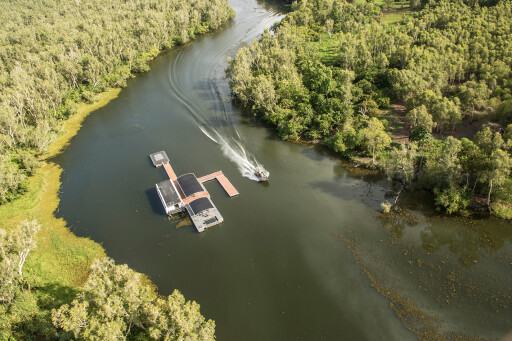
Introductions out of the way, we are soon all bundled into the two airboats for an exploratory tour through the myriad waterways branching off Sweets Lagoon. And it is brilliant; I will confess to being a huge fan of the NT in general and am always keen to see more of it. A stand-out is meeting “Bonecruncher”, a four-metre saltie that has had a large portion of his lower jaw bitten off by another male during a territorial dispute.
It’s nearly like this croc knows when the show is on – it only takes a couple of shouts from Matt aboard his airboat for Bonecruncher to swim over and impress/overawe the punters. Matt’s familiarity with crocs – and his admiration of them – shines through as he gets hands-on with Bonecruncher, describing the various features that make up a saltie while his hand is on top of the croc’s upper jaw. Matt and fellow airboat pilot Ben soon move the two boats farther into the narrow side channels, where the crafts’ powerplants (an LS1 V8 on the smaller of the two, with a PCM [Pleasure Craft Motor] on the bigger one) work hard to push the airboats over sunken logs and branches, as well as shallow sections of the waterways.
It’s a brilliant way to spend a few hours, topped off with fresh-caught and barbecued barra for lunch back at the pontoon. As well as the tours, Matt has started an overnight accommodation venture. Safari-style tents (with showers) are dotted around a beautiful part of his 600-acre property, not far from “The Shed” his work HQ and, as the name suggests, a corrugated iron homestead that houses Matt and his crew. I meet Ben and Cody during my time here, with both of them (like their boss) flat-out tackling numerous tasks around the property. It’s bloody impressive that Matt and his team fit it all into their workday, but it’s definitely got a lot to do with the adage of ‘can’t sit still’ in terms of Matt’s strong work ethic.
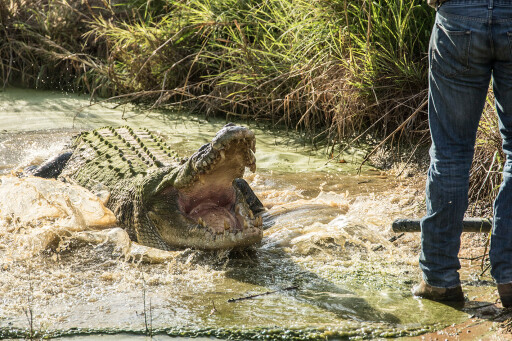
It is this, along with his passion for wild animals, that’s been part of his life since he was a youngster, with his versions of ‘pets’ being decidedly different from most children. “Mum was pretty scared when I was doing it all at the start,” he says. “But even when I was a kid I was catching brown snakes, taipans, tiger snakes – anything deadly I could get my hands on. So she’s got some faith in me now that I can handle myself.”
Balancing act
With the new season of Outback Wrangler about to hit TV screens globally, you’d think Matt would be ready for a short break. But, with his wedding in a few weeks, plus the ongoing expansion plans for his business and pre-production for the next few seasons of the show, this hard-working self-starter won’t see any downtime for a while. It’s a necessity to some degree; the tours and accommodation help fund ideas he has for the TV show, while the show itself repays that with additional exposure for his business – and it is still the ‘big one’ among his various enterprises, he affirms.
“Yeah, for sure, I mean we’ve spent so much time and effort doing it now,” Matt says. “It would be good to see it get reasonably big overseas and it’s good for Australia. That’s sort of what I am pushing now – more for the Territory... and for tourism in Australia.” There’s a quiet confidence that this next season of the show will be the best yet, which should see these hopes fulfilled. “We stepped it up; we’ve done eight half-hours (shows) which pretty much could have been made into eight one-hours, we had so much content,” Matt says.
“We had more places to go to, bigger crocs, and we put a bit more effort in and pushed a bit harder and away we went.”
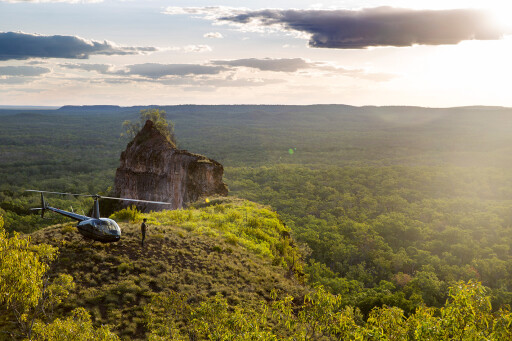 An old stager
An old stager
When viewers see Matt and his crew wrangling crocs out of swamps and rivers the perception for the ignorant could be it’s a cruel thing to do, or that he has little respect for the animal, but the truth is as far removed from that as possible. Matt’s admiration for these huge reptiles is very high and his first thought is always of the animal’s welfare. His ‘soft spot’ is never more pronounced than when he introduces me to the resident of one of the enclosures near The Shed – the crocodilian equivalent of a stately gentleman: Tripod.
As the name suggests this 5.5-metre, 770kg, roughly 80-year-old big bopper has only three legs – his front right leg was bitten off by another male at a croc farm years ago. Matt took him on around 12 months ago after he was copping some rough treatment from younger males at the farm. I take a slightly deeper breath than normal when Matt opens the gate – Tripod is laying half-in/half-out of the water right near it – but the old fella seems content to just sit there in the sun.
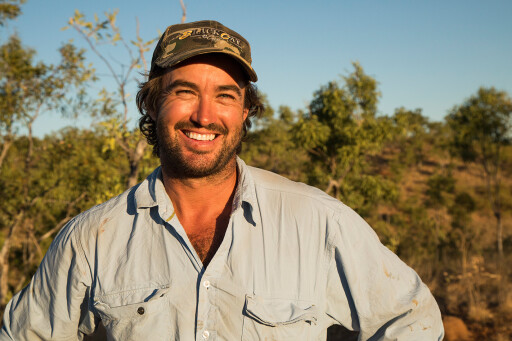
Even Matt’s waving of a pig’s leg in front of him barely causes any movement – nor does Matt’s good-natured comments of “you lazy bugger” elicit much response. And then it happens; just when I thought Tripod wasn’t going to budge, in a split-second he lifts up and lunges, jaws agape, at the bait. I am both amazed and impressed; Tripod is getting on in croc years, yet is still lightning fast and only slightly slowed down by his lack of front foot for that extra leverage.
A few more lunges and ‘clump’ of jaws banging together and he gets his dietary reward. I ask Matt if he thinks there are still older, bigger ones out there. “Oh, there’d have to be. Problem is, with the general public, they see one big croc and you get one redneck and they shoot them,” Matt says with a tone of disgust. “If it had been there for a long time that’s just silly, you know.”
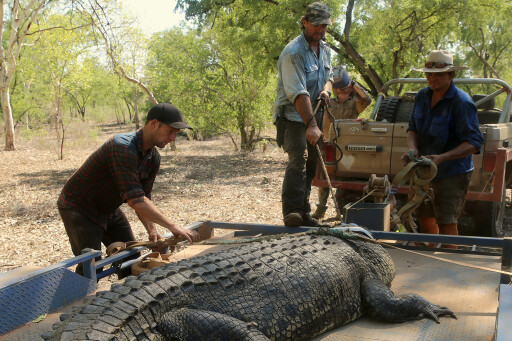 Never slow down
Never slow down
While we’re having a few beers at sunset Matt gets another call: Nat Geo TV is keen to film promo footage tomorrow; the crew is at the nearby Sandpalms Roadhouse ready to go. Oh, and they will need a huge NG border made out of timber for some of the filming. Next minute – and for many minutes after that – me, Matt, Ben and Cody are at the roadhouse, chatting with owners Tommy and Julie, and tucking into some Top End nosh while Matt and the NG TV crew discuss the details for tomorrow’s shoot. Incredibly, it all gets done; by the time I wake up the next morning, Matt has already gone to set up for the filming.
Meanwhile, Cody is dropping me into Darwin for my flight back to Sydney, with a detour to pick up that timber NG border (painted yellow, of course) from a local supplier who was up until 4am finishing it. Just when I thought that, maybe, Matt might actually get that short break, I remember one of the last things he said to me before I left: “I was just talking to Mick on the way out; we’re just about to start collecting crocodile eggs for croc farms as well, and that goes for another five months.”
It is dangerous and exciting work. In fact, you’d reckon there’d be the potential for a hard-working Aussie to make a globally successful TV show out of it...
THE WORKHORSE
Matt Wright has been a Toyota fan since he started driving, owning and using a variety of the brand’s Land Cruiser utes and wagons over his many years working in remote areas.
His latest rig is a moderately tweaked LC79. “I love it, I really do,” Matt says. “It’s a good rig; it’s tough, and it does what I want.” In terms of mods, Matt has kept them to essential things he needed done for the Cruiser to benefit his business.

“I haven’t done anything to it, bar fitting airbags to the rear, a radio and a bullbar and a couple of spotlights,” he says. “That’s all you need really... I just need shit to be practical and work. “Having the airbags is good for loading up fuel, so it carries a lot of weight.
Plus it carries the airboats around – the big one would be 1.5 to 2 tonnes. “The only other thing I have done is remapped the chip for a bit more grunt.”
WRANGLING THE BIG SCREEN
Outback Wrangler Season 3 had its world premiere on National Geographic on Wednesday, December 6 at 8.30pm AEDT. This season contains eight 30-minute episodes. In this season the crocs are bigger than ever and the team face a number of hairy moments, including having their tinny nearly overturned by a particularly cranky croc.
National Geographic is available on Foxtel, Foxtel Now, Fetch and the National Geographic App: www.nationalgeographic.com.au/tv/outback-wrangler

COMMENTS